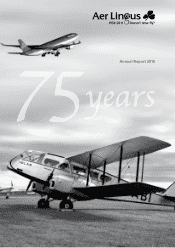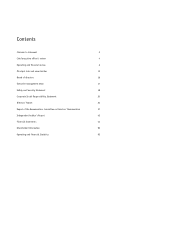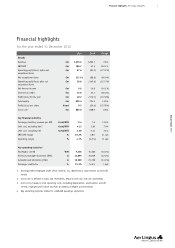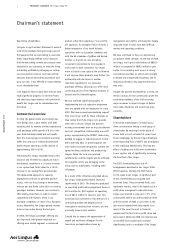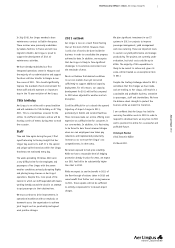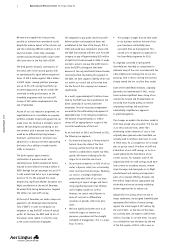Aer Lingus 2010 Annual Report Download - page 9
Download and view the complete annual report
Please find page 9 of the 2010 Aer Lingus annual report below. You can navigate through the pages in the report by either clicking on the pages listed below, or by using the keyword search tool below to find specific information within the annual report.
Annual Report 2010
7
Operating and fi nancial review Aer Lingus Group Plc
The combination of the actions taken in late
2009, the adoption of the market positioning
described above and the implementation of
the actions below, has resulted in the return of
the Group to profi tability in 2010. As
explained in the Financial Review (below) the
Group has produced an operating profi t before
exceptional items of €57.6 million for 2010
against a loss of €81.0 million in the prior
year. This turnaround has been achieved on
fl at revenues in an overall declining market
(e.g. 10% decline in year-on-year Dublin
airport passenger volumes). Revenue was up
0.8% at €1,215.6 million. The fundamental
elements of the strategy and their contribution
to the turnaround are summarised below.
Better matching of capacity
to demand
Short-haul capacity (measured by ASKs) was
reduced by 7.8% compared to 2009, with the
load factor reducing by only 0.5 percentage
points to 74.9%. It is important to note that
the focus in 2010 was not just to reduce
short-haul capacity but to better manage and,
where required, re-deploy short-haul capacity
with the objective of better serving
underlying, natural demand, strengthening the
Aer Lingus network and gaining market share.
In long-haul, capacity was reduced by 24.1%,
leading to a 5.3 percentage point increase in
load factor to 78.4%. Overall, capacity was
reduced by 13.9%, and the load factor increased
by 1.6 percentage points to 76.1%. The
reduction in capacity without an adverse effect
on load factors illustrates that we achieved a
better match between the seats we offered in
2010 and the natural demand in our markets.
Focus on yields
We changed our pricing policy to optimise yield
rather than load factors. Aer Lingus continues
to operate in very price sensitive markets and
the bulk of seats continue to be offered at
what are designed to be attractive low fares.
However, our yield management policy now
recognises that a proportion of the demand for
many of our fl ights is driven by passengers
who are more time than price sensitive,
allowing us to improve yields for bookings that
are made closer to the departure date. Our
changed approach to yield management
resulted in an 11.4 % increase in average fare
per short-haul passenger and a 19.0% increase
in average fare per long-haul passenger.
Connectivity
We have emphasised connectivity, both within
our own network and between our network and
that of our interline partners, as a means of
compensating for weak demand in the Irish
market. Improved interline revenue was a
target in 2010 and we delivered year-on-year
increases in volume and yield. Interline
revenue represented 7.7% of system revenue in
2010 compared with 6.7% in 2009 and we have
continued to invest in relationship management
with our key bilateral partners. This emphasis
on connectivity meant that 34% of transatlantic
sales in 2010 connected behind or beyond our
gateway airports vs. 23% in 2009.
Partnerships & Alliances
A key element of our connectivity strategy was
the launch of the Aer Lingus Regional service
at the end of March 2010. This is operated by
our franchisee Aer Arann. The arrangement
allows us to offer a service and earn a
franchise fee, on routes that would otherwise
be uneconomic with a jet aircraft, as well as
generating transatlantic connections from
provincial UK cities. 20,000 such connections
were generated in 2010. We also launched, in
early 2010, an extended codeshare agreement
with United Airlines to operate a service
between Washington to Madrid. The single
aircraft extended codeshare was launched as a
proof of concept and it has been profi table in
2010.
Aer Lingus needs partners in order to deliver
on its core mission of connecting Ireland with
the rest of the World and we are continuously
evaluating opportunities with airline peers
which will enable us to expand our service
offering. We feel that our product quality and
competitive cost base makes us an attractive
partner.
Review of 2010
The combination of snow and ash disruptions
resulted in an ASK reduction of approximately
5% in 2010 compared to plan. This impacted
revenue performance as a result of cancelled
fl ights and also resulted in costs relating to
passenger compensation and other items. In
addition, unit cost performance was negatively
impacted as fi xed cost remained unchanged
despite reduced capacity compared to plan.
The fi rst quarter of 2010 showed an
approximate halving of operating losses,
largely attributable to lower fuel prices. Early
indications of the success of the shift in
commercial strategy became apparent with the
12.4% increase in long-haul average fare per
passenger, coupled with a 3.8 percentage point
increase in load factor. However, improvement
in short-haul fare per passenger was only 3%
as we had not, at that point, been able to
reduce excess capacity at the London Gatwick
base. This occurred at the start of the summer
schedule at the end of March 2010.
In addition, Q1 2010 was adversely affected
by the Irish airport departure tax, which was
introduced in March/April 2009. March saw
fi nal approval of the Greenfi eld cost reduction
programme following a 74% positive staff
ballot, March also saw the launches of the Aer
Lingus regional franchise and the extended
codeshare agreement with United Airlines for
the Washington to Madrid service.
As we moved into the second quarter,
operations were disrupted by airspace closures
caused by ash from the Icelandic volcanic
eruption. Despite the associated cancellations,
the Group reported an operating profi t before
exceptional items of €18.8 million, compared
with a loss of €18.2 million for the same period
in 2009. The second quarter provided early
evidence of the success of our commercial
strategy with short-haul yields up 13.8% and
long-haul yields up 20.9%. We also started to
implement the Greenfi eld programme and, by
the end of June, had achieved staff cost
savings with an annual value of €29.6 million.

